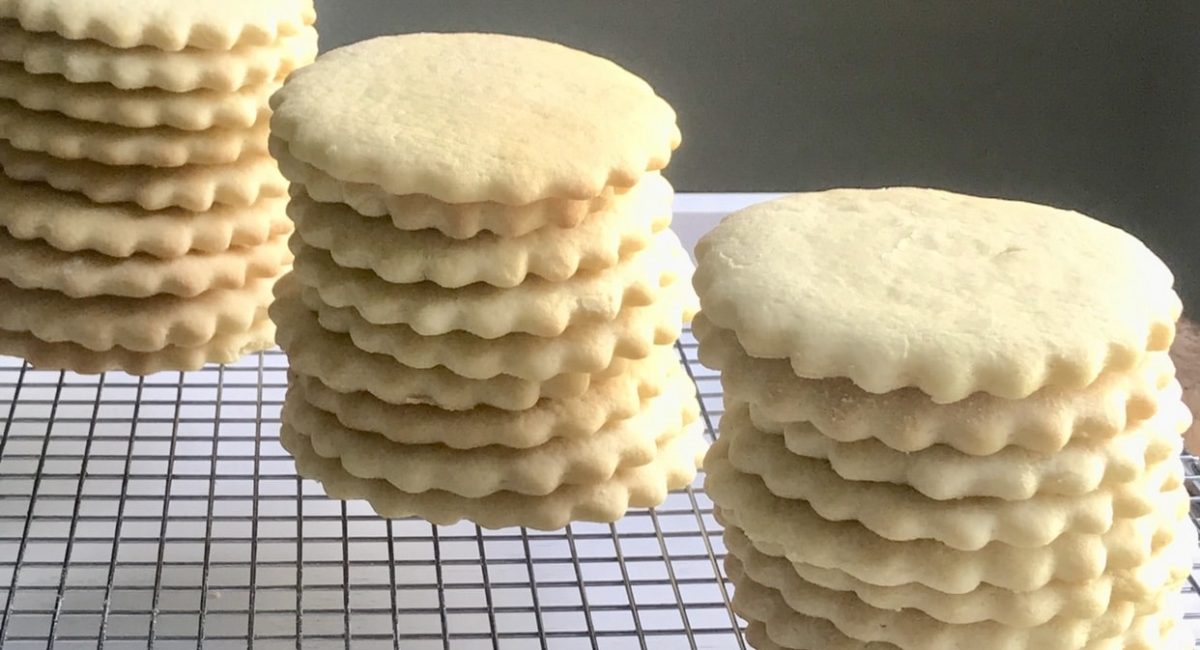By Val Taylor as told to Jada F. Smith
If certain recipes are going extinct, then consider tea cakes an endangered species. Even in a Southern city like Houston, the place I’ve called home for more than 40 years, the round, golden confections have become something of a rarity. They aren’t sold at any coffee shops that I know of, and they aren’t a staple at most bakeries. It can often seem like you have to know somebody who knows somebody in order to find a good tea cake.
But despite them fading from popular culinary culture, those who know about the deliciousness of tea cakes, know. And they don’t play about getting their fill.
In her book I Know Why the Caged Bird Sings, Maya Angelou wrote about a neighbor offering her tea cakes that were so good, she thought it would be a dream come true if she didn’t have to swallow. When I put out a batch at a Father’s Day BBQ for my family one year, the plain little cookie ran out faster than the succulent meats and trimmings. And don’t let strangers find out you have a recipe reminiscent of the one their aunt or grandma used to make. You’ll have a new friend, fast.
The obvious reason for their cult-like status is how good they are: Good enough to excite the tastebuds but restrained enough not to overwhelm them. And as the name suggests, they’re great with a warm cup of tea, but also coffee or lemonade. I think they’re an all-purpose dessert.
From a technical aspect, these are some of the easiest cookies you’ll ever make (from scratch, at least). I like to start the process the same way I do everything else when baking — by reading the recipe all the way through, then gathering and measuring out the ingredients before putting any of them together. The French call it “mise en place,” the process of organizing and setting up the recipe beforehand to make the actual act of cooking flows smooth.
The part of the recipe that can deviate from other cookie recipes is that the dough will need to be chilled overnight. That can be annoying in our current convenience culture, but it’s worth it to get the inner cake-like texture just right. Here’s a pro-tip that I use when it comes to baking: beat the sugar and butter together, long enough for the mixture to get fluffy. Once the flour is added, it’ll create a nice, light, airy baked good.
But for Black people, especially, tea cakes are about more than mere flavor and texture. They also have a cultural history that goes beyond the taste buds, reaching into our collective memory and striking a chord that seems to resonate with a lot of us. After all, this is the cookie that our enslaved ancestors cobbled together with whatever they could get their hands on from the big house. It’s the handheld dessert that Black travelers could easily pack alongside cold fried chicken to nourish themselves when roadside diners refused to serve them. It’s the cookie of family reunions, funerals, church anniversaries, and summer evenings sitting on the front porch with neighbors. It’s the snack that kept civil rights leaders and community organizers full as they strategized ways to get us a little closer to freedom.
For those reasons alone, tea cakes deserve their spot in both the kitchen and the culture for generations to come. They’ve earned it.
I was raised in Chicago, and even though my mama ‘nem were from Mississippi and made all manner of Southern desserts – German chocolate cakes, red velvet cakes, you name it – they never made tea cakes. It wasn’t until I moved to Houston that I had one and understood the hype. They may not have the visual appeal of other, more decorated desserts, but there was a type of inner beauty that enticed me, nonetheless.
However, despite the cookie being under what seemed like obvious threat of not surviving from one generation to the next (even back when I first moved to Houston), I had a hard time finding a good recipe – both through formal channels, like cookbooks, and through the informal ones, like the grapevine. People seemed unwilling to share their beloved family recipes, which I can understand and appreciate, but only to a certain extent.
What happens when nobody in the family learns the process before the keeper of the recipe departs? You and your cousins weren’t the only ones who ate off that recipe. I guarantee you that, at some point, it blessed the whole community: The widowed church deacon; someone on the sick and shut-in list; up-north relatives; the neighbor down the street. What happens to all of them when the keeper of the recipe passes? Must the whole community – the culture, really – suffer?
If no one in the family takes an interest in learning the recipe, share it with someone who does. Young people, if you don’t have anyone in your family to learn from, seek out an elder in your community who’s willing to teach. That’s how I came upon this recipe.
Years ago, I was in the waiting area of an autobody shop and struck up a conversation with an older woman sitting beside me. I just so happened to mention my hunt for a good tea cake recipe, and her face lit up like an old gas stove that sometimes needs a match to help get it going.
“You want to learn to make tea cakes?” she said as if she had been waiting for someone to ask that her whole life. “I got a tea cake recipe that has made me some money!”
Quickly, I began to write the ingredients and directions down on whatever paper I could find in my purse or lying around the mechanics office.
Of all the tea cake recipes I tried, hers was special. It was the only one that included four different kinds of extracts – not just the usual vanilla – and you could taste the difference as that symphony of flavor came bursting through the first bite.
I was so grateful to that woman, who goes by Ms. Crawford. On the surface, she was a stranger sharing one of her most prized possessions with me. But underneath, she was a fellow human being sharing something far less tangible but even more valuable: Community, connection, conversation. All of which, I think, are mixed up in the preservation of this little cookie.
Our communities are stronger when we share things. Preserving and sharing recipes for the foods that bring us together, get us talking to each other, and help us build relationships, memories and stories that can carry wisdom from one generation to the next are important links in a much broader chain. In a way, desserts like tea cakes bridge the gap between the old and new.
All of this is not to say, though, that things can’t change. They should! They must. I think this new generation can adapt, build on, and experiment with the recipes of the past. Make them vegan if you want! Gluten free! Make them more Instagram-worthy, if that’s what gets you going! Whatever you do, young people, don’t let this one become extinct.
And don’t forget whoever put you on, either. Every year since that day in the autobody shop, I call Ms. Crawford around the holidays, just to check in and see how she’s doing, and also to honor the gift she gave me all those years ago. It’s both a recipe and a relationship that our whole community is grateful for.
Val Taylor is not a chef — just a home cook who loves food. She shares cooking tips on her Instagram and Tik Tok channels so families can know the basics of cooking 100 years from now. Follow her for more recipes and cooking tips.


